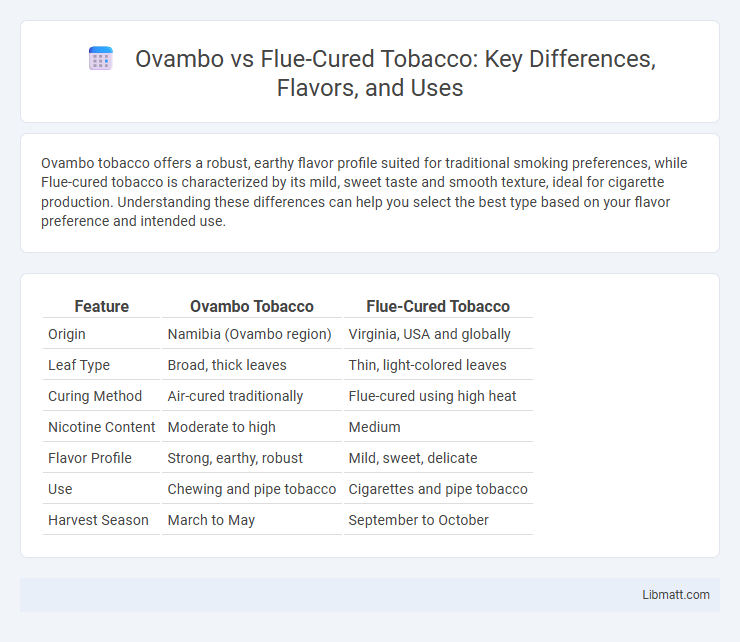Ovambo tobacco offers a robust, earthy flavor profile suited for traditional smoking preferences, while Flue-cured tobacco is characterized by its mild, sweet taste and smooth texture, ideal for cigarette production. Understanding these differences can help you select the best type based on your flavor preference and intended use.
Table of Comparison
| Feature | Ovambo Tobacco | Flue-Cured Tobacco |
|---|---|---|
| Origin | Namibia (Ovambo region) | Virginia, USA and globally |
| Leaf Type | Broad, thick leaves | Thin, light-colored leaves |
| Curing Method | Air-cured traditionally | Flue-cured using high heat |
| Nicotine Content | Moderate to high | Medium |
| Flavor Profile | Strong, earthy, robust | Mild, sweet, delicate |
| Use | Chewing and pipe tobacco | Cigarettes and pipe tobacco |
| Harvest Season | March to May | September to October |
Introduction to Ovambo and Flue-Cured Tobacco
Ovambo tobacco, primarily grown in Southern Africa, is known for its hardy leaves and robust flavor profile, making it a favored choice in regional markets. Flue-cured tobacco, cultivated mainly in the United States and parts of Asia, undergoes a precise curing process that enhances its smoothness and sweetness, ideal for cigarettes. Understanding the characteristics of both Ovambo and Flue-cured tobacco helps you select the best type for your smoking preference or tobacco production needs.
Historical Origins of Ovambo and Flue-Cured Varieties
Ovambo tobacco originated from African heritage, primarily cultivated in Namibia and Angola, known for its unique flavor profile and traditional farming methods. Flue-cured tobacco, first developed in the United States during the 19th century, undergoes a specific curing process involving controlled heat exposure that enhances its sweetness and smoothness. Your choice between Ovambo and Flue-cured varieties can influence the smoking experience and cultivation techniques due to their distinct historical backgrounds and production methods.
Key Differences in Cultivation Practices
Ovambo tobacco requires less irrigation and thrives in semi-arid conditions, while Flue-cured tobacco demands higher water availability and well-irrigated soils. Ovambo cultivation involves shorter curing periods with a focus on air curing to maintain leaf quality, contrasting with Flue-cured tobacco, which undergoes controlled heat curing for a brighter leaf color. Your choice between these varies depending on local climate and soil conditions, impacting yield and tobacco characteristics.
Geographic Distribution and Climatic Requirements
Ovambo tobacco predominantly thrives in southern African regions, particularly Namibia and Angola, where semi-arid climates with distinct wet and dry seasons prevail. Flue-cured tobacco is mainly cultivated in the southeastern United States, Zimbabwe, and parts of China, favoring warm, humid conditions with well-distributed rainfall for optimal leaf quality. Understanding the specific climatic requirements of your chosen tobacco type ensures better yield and leaf characteristics tailored to the geographic distribution.
Leaf Characteristics: Texture, Color, and Aroma
Ovambo tobacco leaves exhibit a coarse texture with a rich, deep green color and a strong earthy aroma, making them distinctively robust. In contrast, Flue-cured leaves are smoother, lighter green to golden yellow, and emit a mild, sweet scent due to the curing process. Your choice between Ovambo and Flue-cured should consider these leaf characteristics to match desired flavor profiles and industry applications.
Curing Methods: Ovambo vs. Flue-Curing
Ovambo tobacco is traditionally air-cured, involving a natural drying process that preserves its bold flavor and robust texture. Flue-cured tobacco, on the other hand, undergoes a controlled heat drying method using flue pipes, which enhances its mildness and sweetness by carefully regulating temperature and humidity. Understanding these distinct curing methods helps you select the ideal tobacco type based on flavor preference and usage.
Flavor Profiles and Smoking Experience
Ovambo tobacco offers a robust, earthy flavor profile with rich, natural sweetness that appeals to smokers seeking a full-bodied experience, while Flue-cured tobacco is characterized by its mild, bright, and slightly sweet taste with a smooth, creamy texture. The smoking experience with Ovambo delivers a deeper, more intense smoke that lingers on the palate, enhancing complexity and richness. Your choice between these tobaccos depends on whether you prefer a bold, hearty flavor or a lighter, smoother smoke.
Economic Impact and Market Demand
Ovambo tobacco, primarily grown in Zimbabwe, holds notable economic significance due to its robust local market demand and contribution to smallholder farmer incomes, supporting rural livelihoods and boosting regional economies. Flue-cured tobacco, dominating global markets with high-quality standards and extensive export value, drives substantial revenue streams for countries like the United States, Malawi, and Brazil, influencing international trade and agricultural policies. Market demand for flue-cured tobacco remains strong among cigarette manufacturers worldwide, while Ovambo's niche market presence caters to regional consumption, impacting pricing dynamics and supply chain structures in their respective economies.
Health Implications and Chemical Composition
Ovambo and flue-cured tobacco differ significantly in chemical composition, with Ovambo containing higher levels of nicotine and tar, increasing potential health risks. Flue-cured tobacco typically has elevated sugar content, which affects the combustion process and alters the delivery of harmful chemicals during smoking. These chemical differences influence their respective health implications, as Ovambo's higher toxicant levels may lead to greater respiratory and cardiovascular harm compared to flue-cured varieties.
Future Trends in Tobacco Production
Ovambo tobacco, known for its robust flavor and high nicotine content, is gaining attention as future trends prioritize organic and specialty tobacco markets. Flue-cured tobacco remains dominant in traditional cigarette production due to its smooth taste and consistent quality, but sustainability practices and reduced chemical use are reshaping its cultivation. Your investment in tobacco production should consider the shift toward eco-friendly farming and consumer demand for diverse tobacco varieties like Ovambo.
Ovambo vs Flue-cured Infographic

 libmatt.com
libmatt.com